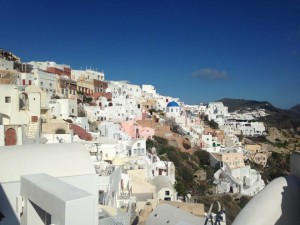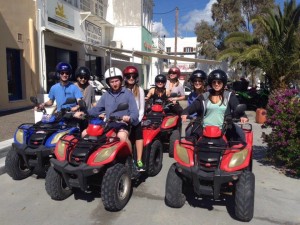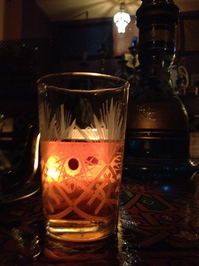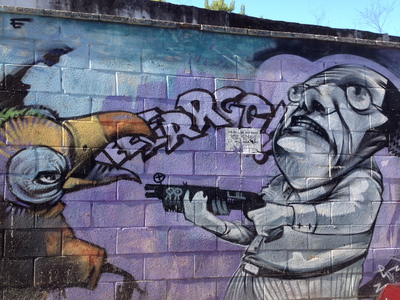
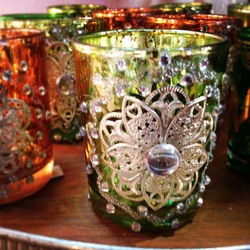
Both of the above are from a chic little antique/interior decoration shot near CIEE.


I may have mentioned it before, but breakfast is not a very big deal here – toast and coffee are enough, but I will certainly appreciate adding a nice omelette, or some cereal to this mix once I’m back in the States. Also notice: my se�ora has the most oldschool, but also fastest and coolest toaster I think I’ve ever seen. Hands down. Also, the coffee maker is juuust big enough for one cup 🙂

Me, Pat and Randa heading home after an afternoon in the sunshine by the river.
Brace yourself.
Okay, this is just about the most gigantic blog entry imaginable, as it’s been quite a while since I wrote anything, but it’s pretty much split into two sections: classes, and miscellaneous topics, in that order, so feel free to ignore the irrelevant and read what ever interests you!

Regular Semester Classes.
To the left is a screen shot from my iPhone of my “horario finalisisimo,” so named by Jorge, one of the people who works in CIEE, and changed my schedule about five times x) Good thing though, because it’s finally perfect 🙂
I start the week pretty relaxed, I don’t have my first class until 7pm on Monday afternoons. I usually spend the earlier part of the day getting work done and/or going for a run by the Guadalquivir (that’s the name of our river, I can never remember it, and have a feeling a lot of other people can’t either – explaining why it’s normally just referred to as “el r�o”), and now that it’s starting to get nicer out, the latter of the two will likely become more common.
Below is a screen shot of the GoogleMap of the area (Paseo Rey Juan Carlos) that I usually run in. I don’t normally go the entire way down and back (10km, about 6 miles) – I usually cut off a kilometer or a few – but when I do it feels great, and I get to see the entire north side of the river 🙂

Psych
Anyways, after my laid-back Monday afternoons, my first class is “Psicholog�a de la Aprendizaje de una Segunda Lengua” (Psychology of Apprehension of a Second Language), which is totally right up my ally. The second week of class, I volunteered to do the presentation for the week with Randa and my friend Patrick, from Spanish 410 at Penn State last semester (holler!). It was on popular ideas about learning a second language and we totally killed it, if you ask me 😉 I like this class a lot, but so far we’ve just covered basics that I know most of from taking so many similar classes at PSU. It’s nice to be well versed in the subject, and be able to ask the professor things I want to explore deeper, but being that he knows this is my area of focus in university, I’m assuming he’ll be harder on me when it comes to grading. Also, though it’s one of my favorite subjects, there have been some readings and points in this class I’m not as fond of. One of the first articles we read ran pretty contrary to a lot of my personal beliefs about language systems and acquisition, which are many, varied and heatedly debated in the world of linguistics, because we’re always searching for the best ways to teach language. At any rate, there are also many new and different ideas from what I’ve heard and seen in the past, and I’m enjoying the fresh wave of information that brings.
Islam.
On Tuesdays, I start class at 11, “El Islam en La Espa�a Musulmana (Al-Andalus): Arte y Cultura” (Islam in Muslim Spain: Art and Culture). It isn’t so bad that it’s in the morning, because I like the subject a lot, but the timing makes for an awfully long day on Tuesdays and Thursdays. I absolutely love this class, yet another where I’m “THAT GIRL” who’s always answering questions and asking the professor for details, but hopefully that’s a good thing and shows that I’m interested, not just a pain in the neck or showoff to the other students! x) Anyways, the professor is wonderful, and the readings (written by her, in Spanish, also how my psychology and three cultures classes are) are really interesting. So far, we’ve reviewed Islam as a whole, and are now getting into the “Medieval Arabic World and Historical Notions”, and then architecture. I have to write at least 3 pages, (1,5 spaced/11pt font – not 2,0/12 pt like in the States!!) in Spanish about each for next week, and that’s a normal amount for a few-week unit in this class. I have that, directly followed by another at 1 o’clock, and as you’ll see, they overlap a LOT. I’m glad to say though, that is definitely facilitating my absorption of the subject matter – so far it’s a lot of review, but I’m definitely also learning a lot!
Three Cultures.
That next class is “Tres Culturas en Espa�a: Crisitianos, Muselmanes y Jud�os” (Three Cultures in Spain: Christians, Muslims and Jews) which I also enjoy a lot. Again, most of what we’ve covered so far is basics and review (for me, at least – this is a topic I’ve always been really interested in), but learning the details and cultural aspects that are unique to Spain is really fascinating. The professor talks really fast, but very clearly, so we cover a lot of subject matter in each class in a way that manageable as long as you do the readings, which again, are great.
Bocadillo
After that, I usually go find a spot in the sun to read and do homework at a square or a caf� while I eat my lunch. Tuesdays and Thursdays I don’t go home for lunch, so my se�ora packs me a “bocadillo” (pronounced BOHKA-DEEYO – a sandwich) to eat. This is the norm for all the exchange students, and usually consists of a loaf of fresh bread the size of a small slipper, with a slice of meat and some cheese or lettuce and tomato. Sometimes she throws in a drink, orange, and other “postre” (dessert), but when there’s no drink, I like to go enjoy my meal with a “cerveza” (beer, which I don’t usually drink, but is generally MUCH better here than anything I’ve tried in the States).
By the way, this is an example of what I sit in front of while I eat my lunch 🙂

^ This is the Cathedral of Sevilla, it’s kind of a big deal. And just plain big.

And La Giralda, at its side ^
Linguistics.
After my two-and-a-half hour siesta, I have another class at 5PM, “Lexicolog�a y Sem�ntica Espa�ola,” (Spanish Lexicology and Semantics). What on earth does that mean? It means another class I’m obsessed with!! Though it’s moving a little slow because it’s still pretty close to the start, we’ve covered some interesting topics. After we got through some of the basics of linguistics (none of the other students in the class have ever taken a ling class – understandable, as it’s not a very common subject, but I was a little surprised I’m the only linguist in my whole program!), we got on to talking about pr�stamos (borrowed words), origins of Spanish words, and sefard�, or judeoespa�ol (Jewish Spanish!)
Seminar.
Then there’s my extra class, which is only 2 credits, but will be good for my resum�, and will earn me the CAIE (Certificate of Achievement in International Education): Seminario sobre vivir y aprender en Sevilla (Seminar on Living and Learning in Seville). For that, I have to have a “compa�ero cultural,” a cultural partner, which is someone Spanish who I spend time with setting goals and doing specific assignments to get to know Sevilla and Spain better. My partner is H�ctor, someone from Chefchaouen, the teter�a that Randa and I go to all the time and have friends at. Our most recent assignment was to ask our cultural partners the meaning of their names and then discuss how it’s different from ours. Though I know people here take their mother and father’s last names, it was still interesting to see Olga’s (our professor, and head of the program I’m in) list of influences that can have a role in naming someone. There were religious, family, cultural, historical, all sorts of reasons people name their kids. Turns out H�ctor was just named that by his parents because they thought it was nice and his dad didn’t want to give him his name because he didn’t like it. I learned though, that H�ctor is a Greek name which I never knew before and wouldn’t have guessed! Ironically, around the same time that I got that assignment, a Jordanian teter�a owner I met told me that my arabic name (al-hana) means “relaxation,” or “happiness.” 🙂
 Finally done for the week a little before 7pm on Thursdays (we “extranjeros” – foreign students – don’t have class on Fridays), I trudge home with all my books, have dinner, and muster up the energy to go out and spend some time with Randa and kids from our program or, more often, go find some of our local friends to hang out with. Overall, it’s a manageable week, but if I want to be sufficiently prepared for my classes and be able to participate at all (which we’ve discovered, I very much do), it’s a pretty heavy time and energy investment to get all the reading done. And let’s be real – I’m not usually big on reading. I’m glad though, that I like all my classes and professors so much. I was originally going to take an art history class through direct enrollment at the university, but after sitting in on one lesson, I found it to be WAY too much
Finally done for the week a little before 7pm on Thursdays (we “extranjeros” – foreign students – don’t have class on Fridays), I trudge home with all my books, have dinner, and muster up the energy to go out and spend some time with Randa and kids from our program or, more often, go find some of our local friends to hang out with. Overall, it’s a manageable week, but if I want to be sufficiently prepared for my classes and be able to participate at all (which we’ve discovered, I very much do), it’s a pretty heavy time and energy investment to get all the reading done. And let’s be real – I’m not usually big on reading. I’m glad though, that I like all my classes and professors so much. I was originally going to take an art history class through direct enrollment at the university, but after sitting in on one lesson, I found it to be WAY too much

information to take in, especially being that I’m not accustomed to organizing facts about artist, styles, and dates in the way or rate the professor went about presenting them. In place of that though, I’ve found myself quite happy in the Islam Art and Culture class. Thankfully, no matter how tough classes get, at the end of the week the last thing I see walking home are views of Triana like these form my bridge.
Desarrollo de una Identidad Espa�ola: (Development of a Spanish [and Global] Identity)
Aside from the discussions we have about linguistic identity in our psych class, it’s pretty neat keeping track of my development of a Spanish (linguistic) identity. There are certainly things that I only think of in Spanish now – especially things having to do with classes, because there’s no English there – and at times it’s actually hard to translate or think about them in English. I even think and talk to myself in Spanish a lot now, it’s kind of weird! It’s also still strange having certain people who I code switch with A LOT (like H�ctor, Vincent, and other friends at the teter�a), and others who hardly speak any English with me, like a lot of me and Randa’s Spanish friends who are older or have stayed in Spain all their lives. Especially when I’ve been speaking a lot of Spanish, and someone like H�ctor wants to know a word in English – if it’s not a common, everyday word that I use a lot, it can take me hours to suddenly realize what it is. The other day he had sores on his hands from rock climbing, and I could not for the life of me come up with the word callus, which happens to be a cognate of the Spanish, “calico.” What are the chances? Pretty good actually, things like that are often cognates…A little unrelated, but even crazier is the amount of code-switching that goes on when Randa and I meet other Moroccans. The owner of “Al-Salam” (The Peace) Teter�a, a new favorite spot of ours for great tea and hookah in Triana, is from Jordan, and his wife from Marrakech, so Randa enjoys practicing some Arabic with them. That sometimes includes some Spanish, English and when Muhammad talks to me about Israel, he shows off his bit of knowledge of Hebrew! It’s pretty wild, and really neat at the same time.

On the note of identity, “De donde eres?” (Where are you from?) has become a question that sparks some of the most interesting conversations I’ve had since I’ve been here. Most “estudiantes extranjeros” (foreign students) are found out to be American about two words into their first encounters with Spaniards (if they haven’t already figured it out from looks), but no one can ever seem to figure out where I’m from. It’s actually become somewhat of a funny game to make people guess what ethnicit(ies) I might be. Until more than a few sentences in, a lot of people think I’m Sevillana, and don’t believe I’ve only been here a little over a month, which is pretty awesome. Not only because it’s “trendy” to be European, but because people take me more seriously – or so I’d like to think. It would be cool if I could sustain that belief through a whole conversation by the end of the semester! Among the different nationalities that people guess, so far I’ve gotten M�xicana (mostly when I’m with Randa and she speaks first, as she has a more Spanish-American accent, being from the West Coast) a couple times, but I really don’t think either of us looks the least bit Mexican. She strikes me as really obviously Moroccan, and it surprises me that people here don’t guess that first, as I’d imagine they’re more accustomed to meeting Moroccans than Mexicans, they only live a few hours away! It’s interesting to see that much of the time people judge more based on accent than on looks.
Anyways, when I went to C�diz I met a lot of people and one guessed about 7 countries in Europe I might be from, but not Russia, Israel, OR America! The closest anyone got was Bulgarian, which I’m not even sure how right or wrong that might have been, being that I only have a few friends from Bulgaria to compare with. I also had someone I met the other day convinced I was Argentinian (tried to tell him I was most definitely not, haven’t ever even been to South America), until he went home and added me on FaceBook! Apparently the fact that I have light eyes really throws people off (refer to above photo, haha – taken just after I arrived in Spain – which now feels ages ago!). Ironically, Mohammad, just after telling me the arabic meaning of my name, also said I have a middle-eastern face, which is believable enough. I think what it comes down to is that people are biased based on what they know and have seen, because apparently I could be from pretty much anywhere except the majority of Africa. In the end, I always tell people that I’m Russian/Israeli but have lived most of my life in America, speaking English and practicing Spanish, (among the mish-mosh of other languages I’ve dabbled in). People are always asking me to talk to them in Hebrew or Russian, and because I haven’t practiced either in a classroom in over a year, so it’s REALLY hard.
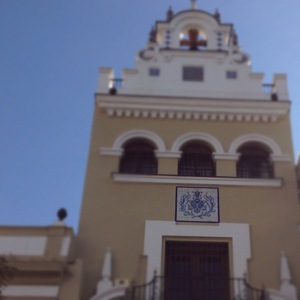
The neatest thing about revealing my identity though, is that most people are really interested and surprised by the “Hebrea” part. When I went to Granada, I had some really interesting conversations with two staff members from CIEE who have studied Judaism and the Jews’ role in Spain, which they both agreed had a huge impact on economic development before they were kicked out along with the Muslims in 1492. They also both listen to and love Israeli music, so I showed them some of mine, and told them about Israel. One of them even told me that I was the first Jewish person he’d ever met! Well, I imagine I’m just the first that he knew was Jewish – there are a TON of Jewish kids here just this semester, and I’m sure without a doubt he’s met a lot of others in past semesters, without realizing it. The picture above is of a building that’s currently something else, but I think used to be a synagogue. It’s neat to see that here, but a little sad knowing there are only about 30 Jewish families left in the city since their expulsion in 1492.

Estrellas y Famosos (Stars and Celebrities!)
I sat down one night to watch TV with my se�ora and her mom after dinner, we were watching a Spanish awards show, and I just had to write something about it, because they all look FABULOUS. The clothes are so classy and beautiful! I actually think they’re nicer than what celebs wear in the States, and further interesting are the roles they play on stage. One woman, reminiscent of a straight, European Ellen Degeneres, came out and started dancing around and singing (just like Ellen, not like a professional), and was then accompanied by a group of other people singing and dancing – slightly off-beat, and slightly out of pitch. ‘Hmm..’ I thought to myself ‘I wonder if they’re just actors performing for the opening?’ So I asked Loly. Indeed, they were all hosts and nominees of the awards show, none of whom regularly sing or dance, but unafraid of looking foolish or sounding out of tune, they opened with a show-tuney number! I thought that was pretty cool. Maybe people do that in other places too – I mean, I wouldn’t know, I don’t really watch TV unless someone turns it on in front of me – but I thought that was an interesting reflection of peoples’ willingness to perform the way they do in this country. And that doesn’t just go for celebrities. Everywhere we go, there are different people telling us about their flamenco endeavours, and singing – even if they’ve never had a single lesson – it’s just part of the culture, which I find really cool.
Also, sometimes you’ll just randomly see a group of people filming a scene for a Spanish TV show or film (like above). Outside StarBucks a few weeks ago, there were some women sitting at a table with a microphone hanging over their heads, and a cameraman working hard to catch all the right angles. Then Randa and I saw some people filming under our bridge the other day when we were walking home. Had no idea who they were, but everyone was looking over the edge, trying to figure out what was going on.
 Teter�a.
Teter�a.
I think I must have mentioned the word teter�a at least 20 times since I started blogging, so here’s a picture of some tea and hookah Randa and I had the other day at the new place, Al-Salam 🙂

This particular place, by the way, has DELICIOUS tea, and really nice sheesha. We tried limonana (arabic for lemon-mint), which is my all time fave.
Location: Triana. Sevilla, Spain.



